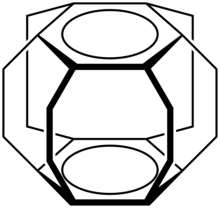Phane
As Phane are chemical compounds referred to, consisting of an aromatic , made by a usually aliphatic bridged chain. They largely correspond to the ansa compounds (Latin ansa = handle), i.e. the planar, aromatic compounds that are bridged by a handle that consists of a chain. At IUPAC , -phan is also the nomenclature ending (a kind of shorthand or representation of chemical compounds) in which rings are understood as superatoms .
Classification
If the aromatic is a benzene ring , the compound is known as cyclophane (composition of cyclo, phenyl and alkane), whereby the term is mostly used for molecules in which two benzene rings are bridged to one another via at least two aliphatic chains (also called handle compounds) on opposite carbon atoms are. The latter therefore belong to the group of polycyclic aromatic hydrocarbons . The most important compounds are the metacyclophanes (I), paracyclophanes (II) and [n, n '] cyclophanes (III). There are also orthocyclophanes . If phanes contain heteroatoms in the aromatic ring, they are called heterophanes . If the heteroatoms are located in the bridge, one speaks of heteraphanes . If one of the atoms of the compound (for example a hydrogen atom) points inwards, we speak of in-cyclophanes .
If the maximum possible bridging has been achieved, one speaks of a superphane . Finally, cyclophane complex compounds with transition metals are referred to as metallacyclophanes .
For the nomenclature of the Phane, the IUPAC has developed a simple procedure, which basically consists of an exchange nomenclature in which the individual cyclic subunits of the compounds are interpreted as superatoms and placed on a par with the other ring atoms and are numbered consecutively.
history
In 1937 Arthur Lüttringhaus (1906-1992) first described the Ansa connections. The cyclophanes were synthesized by Brown and Farthing in 1949 and studied in depth by Donald J. Cram and H. Steinberg in the early 1950s. The first ferrocenophanes were synthesized by Lüttringhaus and Kullik in the late 1950s.
Properties and use
Phane are characterized by unusual chemical and physical properties, such as high reactivity, high ring tension, chirality and molecular parameters that deviate from the norm. Because of their special geometric structure, cyclophanes are excellent building blocks of supramolecular chemistry. The simplest representative of a cyclophane would be a benzene ring with an alkane as a bridge. The best known cyclophane is [2.2] paracyclophane , which was extracted from polymers by Brown and Farthing in the early 1970s. It can be represented via pyrolysis of p-xylene ( Swarc pyrolysis ), Hofmann elimination or Wurtz coupling . Other processes for the preparation of cyclophanes, e.g. B. Flash vacuum pyrolysis for the production of [3.3] cyclophane are possible. Since macrocyclic cyclophanes can form tube-like structures, they can accommodate smaller molecules and thus serve as transporters. Similarly, cryptophanes , which are formed by covalently linking two cyclotriveratrylene units, can also serve as containers for other molecules. They belong to the inclusion or cage connections . In nature, some cyclophanes occur in actinomycetes (e.g. in the form of rifampicin and rifabutin ) and blue-green algae (e.g. nostocyclophane ).
literature
- Fritz Vögtle ; Cyclophane chemistry - syntheses, structures, reactions; Teubner Study Books 1990; ISBN 978-3-519-03508-4 .
- Caroline Berns: Synthesis and biological testing of functionalized cyclophanes of different ring sizes as oxa analogues of cytotoxic natural products . Munich 2004, DNB 971997632 , urn : nbn: de: bvb: 19-21774 (dissertation, University of Munich).
- WH Powell: Phane nomenclature - I. Phane parent names (IUPAC Recommendations 1998) . In: Pure and Applied Chemistry . tape 70 , no. 8 , 1998, doi : 10.1351 / pac199870081513 (free full text).
- HA Favre, D. Hellwinkel, WH Powell, HA Smith Jr., SS-C. Tsay: Phane nomenclature. Part II. Modification of the degree of hydrogenation and substitution derivatives of phane parent hydrides (IUPAC Recommendations 2002) . In: Pure and Applied Chemistry . tape 74 , no. 5 , 2002, doi : 10.1351 / pac200274050809 (free full text).
Web links
- Uni-Kaiserslautern: Host-Guest Systems - Cyclophanes
- The World of Cyclophanes
See also
Individual evidence
- ↑ a b c Muxin Han, Vanessa Maria Brake: Page no longer available , search in web archives: Cyclophane - properties, syntheses, reactions ( page no longer available , search in web archives ) Info: The link was automatically marked as defective. Please check the link according to the instructions and then remove this notice. (University of Göttingen; PDF; 204 kB).
- ↑ Molecular Aesthetics - Pretzels, Bridges, Bembels, Jugs, Cages and Crowns (PDF; 2.5 MB).
- ↑ Entry on Ansa compounds . In: IUPAC Compendium of Chemical Terminology (the “Gold Book”) . doi : 10.1351 / goldbook.A00374 Version: 2.3.1.
- ↑ Dieter Hellwinkel: The Systematic Nomenclature of Organic Chemistry: Instructions for Use, p. 69ff; ISBN 978-3-540-26411-8 .
- ↑ Horst Prinzbach: Memories of Arthur Lüttringhaus (1906-1992). In: European Journal of Organic Chemistry. 1998, 1998, p. 735, doi : 10.1002 / (SICI) 1099-0690 (199804) 1998: 4 <735 :: AID-EJOC735> 3.0.CO; 2-N .
- ^ CJ Brown, AC Farthing, Nature (London), 1949 , 164, p. 915.
- ↑ Donald J. Cram et H. Steinberg, J. Am. Chem. Soc., 1951 , 73, pp. 5691-5704.
- ↑ A. Lüttringhaus, W. Kullick: Ansa-ferrocene. In: Angewandte Chemie. 70, 1958, p. 438, doi: 10.1002 / ange.19580701407 .
- ^ Henning Hopf : Multiple bridged cyclophanes. In: News from chemistry, technology and the laboratory. 28, 1980, p. 311, doi : 10.1002 / nadc.19800280505 .
- ↑ Tetsuo Iwanaga, Ryoma Nakamoto et al. a .: Cyclophanes within Cyclophanes: The Synthesis of a Pyromellitic Diimide-Based Macrocycle as a Structural Unit in a Molecular Tube and Its Inclusion Phenomena. In: Angewandte Chemie International Edition. 45, 2006, p. 3643, doi : 10.1002 / anie.200504499 .


